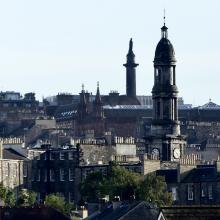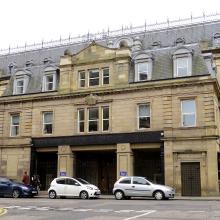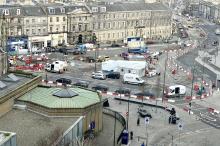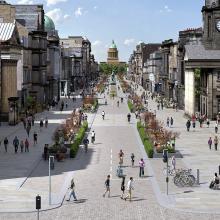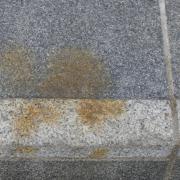
Spot of bother for the St James Quarter
Is the St James Quarter starting to rust?
Rather surprisingly, the answer may be yes. At least parts of it, if one local’s misgivings prove correct.
Antony Jack lives close to the Quarter’s St James Square, and has been a long-suffering observer of its progress over the years.
In recent weeks, since colder weather has set in, Jack has noticed the appearance of these reddish-brown spots on the steps of the Grand Stair.
The spots form at the joins between different tones of granite used in the steps. Jack suggests a cementious product used in laying the steps in February 2021 may not have set effectively owing to cold conditions, and this is why water is managing to get in (and out from what he terms ‘springs’).
He suggests salt used as a de-icer on the nights of 2/3 and 4/5 December 2021 could have entered gaps here and interacted with some ferrous material underneath. (Our photo below was taken on the weekend of 26/27 February 2022.)
In part of a written submission shared with Council officials, elected representatives, St James Quarter managers, and others, Mr Jack states:
‘Thereby it can be deduced that the rust could be from either the reinforcing bars of the stairs’ concrete sub-structure; or the deduced ferrous strip holding the two-tone veneers together.
‘As there is no rust staining at the ‘springs’ it can be further deduced that the ferrous strip used is not marine quality stainless steel […], and that as rusting is expansive the ferrous strip may break up the step’s edges, which may in time cause a health and safety hazard. (The same happened after the 19th century repairs to the Parthenon using unprotected iron stabilising pins.)
‘The deduced environment under the granite veneer of Tuffbed® – containing rainwater, oxygen, and salt – is ideal for rust to develop quickly, hence the rust spots on the steps after a couple of months, and there’s no information, that I have, of how long these granite veneers have been hanging around in their crates, and in what conditions.’
So soon, so soon
If the wrong kind of steel was used here, one wonders where else in the St James Quarter such problems may occur in future.
‘Whatever the cause, and whatever the outcome on these veneers,’ says Jack, ‘the crumbling concrete heritage left by Frank Lloyd Wright in the US, and from 1960–70s architecture in the UK would be best avoided in Edinburgh.
‘This is a lesson we’ve already learnt, we don’t need to learn it again!’
On a point of detail, he has already raised elsewhere the issue of salt being corrosive and a pollutant, with likely detrimental effects on the St James Quarter’s reinforcing, the pumps below the B3 car park, and neighbouring listed buildings.
One step at a time
Mr Jack has a history of detailed and tenacious correspondence on matters of public interest. His most recent observations form part of a much longer objection to siting new artwork on the steps (to which we shall return, but see Issue 315, p. 3). He argues that the rust problem should certainly be addressed before a sculpture is installed here.
We approached Nuveen and the St James Quarter for a comment yesterday and will add any reply we get to the end of this article.
Got a view? Tell us at spurtle@hotmail.co.uk and @theSpurtle
